|
The Reverend Charles Edward
Ranken
and Mid-Victorian Correspondence Chess
by John S. Hilbert
(posted 10 November 2005)
For
Javascript Replay of all the games (in a separate window) click
here

The Reverend Charles Edward Ranken
(January 5, 1828 - April 12, 1905)
The Chess Monthly, May 1891, p.257 |
Death by accident. Death by heart disease. Common enough endings,
yet undoubtedly very few men mange both. A rare example marked
the abrupt passing of the Reverend Charles Edward Ranken, when
the British Chess Magazine in 1905 noted the seventy-seven-year-old
contributor's "immediate cause of death was bronchitis and heart
disease, aggravated by shock arising from an accidental fall
of some 14 feet over the banister of the stairs in his house.
The accident followed sudden heart failure." Or perhaps the
reverse?
Three days later, on Saturday, April 15, 1905, the Reverend Ranken received his last chapel service at the hands of the Reverend Canon Pelly, Vicar of Malvern, where Ranken had lived the last thirty-four years of his life. His graveside service was given by his brother, the Reverend W. Ranken, resulting in a kind of ecclesiastical double-check that might well have appealed to Ranken's hovering spirit. With his passing England saw severed one of her last connections with early Victorian chess. Gone, too, was a man who valued correspondence play.
Born on January 5, 1828, at Brislington, near Bristol, Ranken
learned chess from his father at the age of twelve. It was not
until about 1847 or 1848, through 1850, however, while attending
Wadham College, Oxford, that Ranken received serious instruction
in the game, as well as serious practice with Robert Barnett
Brien, then a Scholar at Balliol College, Oxford, as well as
with the Reverend John Coker, then Fellow of New College. Under
their tutelage, and following a close study of Staunton's Handbook,
the young Ranken became proficient at chess.
His first contribution, however, was neither in correspondence
nor over-the-board play, but rather through problems. Several
of his contributions were deemed worthy enough to see publication
in Howard Staunton's Illustrated London News chess column,
one of which is reproduced below. It's date of publication suggests
Ranken early on was an admirable chess student. Although by
modern standards less than ideal, its solution does suggest
some artistic chess talent.

Mate in Three
By C. E. Ranken
Problem No. 246
Illustrated London News, October 7, 1848
(Solution at article's end.)
A twenty-three-year-old Ranken entered the knock-out "Provincial Tournament" associated with London 1851, the latter remembered today as the first great chess tournament. While Anderssen was winning his laurels over the likes of Staunton, Horwitz and Löwenthal, Ranken made his way through the pairings in his own event, defeating a player named Robinson 2-0 in the first round, Deacon 2-0 in the second, and a player named Hodges, 2-1, with 1 draw, in the third. (An unfortunate historical error occurs in ChessBase's Big Database 2004 at this point: Ranken's opponent named Hodges is mistaken for Albert Beauregard Hodges, the American master not born until ten years later, in 1861). Only in the fourth and final round did Ranken lose, to Samuel Boden, 2-1. Thus Boden won the Provincial Tournament while Ranken took second prize.
But as for so many of us, the practical realities of earning
one's livelihood took precedence over his chess play, and Ranken
drifted from the game for over a dozen years, until in 1864
he was made curate of St. John's, Richmond, Surrey, where his
interest in the game was revived by another English clergyman
of great chess ability, the Reverend William Wayte. Wayte was
then teaching at Eton, his alma mater, where he returned after
achieving high honors in Greek at Cambridge University. A very
strong amateur, Wayte figured prominently in returning Ranken
to his love of the game, as the two played many exciting battles
over the years. Many of their games were featured in The
Chess Player's Magazine between 1865 and 1867.
In 1867 Ranken became Vicar of Sandford-on-Thames, which led him to reside in Oxford, and there he became friends with a Merton College undergraduate named Randolph Churchill, later Lord Churchill, father of Winston. At Churchill's request, Ranken resurrected the Oxford University Chess Club, and was immediately elected president for his efforts.
Four years later Ranken resigned his living at Sandford and moved to Malvern, where he lived the rest of his life. Active in the Counties Chess Association tournaments over the next dozen or more years, Ranken won two of them, his greatest success coming in his own backyard, at Malvern 1872, where in the fifteen player event he finished first with a worthy score of 12-2, half a point ahead of the strong amateur Edmund Thorold, followed by his friend, Wayte, at 10½-3½.
But the occasional provincial meeting was not sufficient to
satiate Ranken's love of chess, and it is while Ranken lived
at Malvern that correspondence chess enters the story. Perhaps
it is fitting that in playing correspondence chess, he turned
back to Staunton's column, sending the aging chess figure the
following correspondence game. Although Staunton usually annotated
the games appearing in his column, the notes to this one were
provided by Ranken. Ranken enjoyed annotating games, and would
in the years to come provide commentary on an untold number
of contests. Staunton did, however, refer to this effort as
"a well-contested game."
N. Fedden - Ranken [C50]
Correspondence Game, 1873
1.e4 e5 2.Nf3 Nc6 3.Bc4 Bc5 4.0-0 Nf6 5.b4 Bxb4 6.c3 Be7
This is thought by many to be at least as strong as the customary
move of ...Ba5. 7.d4 exd4 8.e5 Ne4 9.cxd4 d5 10.Bb3 0-0 11.Ne1
f5 12.f3 Ng5 13.Bxg5 He would have done better, perhaps,
by retaining this bishop, and playing f4 at once. 13...Bxg5
14.f4 Be7 15.Nc3 Be6 16.Nc2 Na5 17.Ne3 c6 18.Bc2 b5 19.g4 Nc4
20.Nxf5 Bb4 He might also have played ...g6 here advantageously.
21.Qd3 g6 22.Nh6+ Kg7 23.g5 Some interesting variations
spring from White's advancing his f-pawn at this point; but
Black's reply ...Qg5 appears to give him a superiority in every
case. 23...Rxf4 24.h4
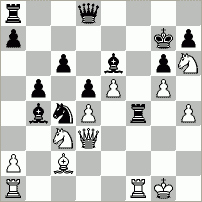
24…Bxc3 With the intention of taking the adverse Queen
from her strong post at d3; but it would probably have been
equally good play to have reserved the bishop, taking the h-pawn,
instead of exchanging pieces. In that case, when the White rook
was played to f6, Black could have defended his g-pawn by moving
...Qe8, still threatening ...Rh3. 25.Qxc3 Rxh4 26.Rf6 Rh3
27.Qe1 c5 28.Qf2 The best move. Had he taken the pawn with
pawn, Black would have played ...d5 with a vigorous attack.
28...Ne3 Black was afraid to take the d-pawn with pawn
here on account of the reply, Bd1, for if after that move he
played ...Ne3, White would have answered with Qf4, followed
by Rc1. 29.Qf4 Had he captured pawn with pawn now, Black
could have either played ...Rc8 or taken the bishop with knight
and followed with ...d4, or ...Rg3+. 29...Qe7 30.Bd3 c4 31.Bf1
Nxf1 32.Rxf1 c3 The only move by which he could win. Any
other would have allowed his opponent to make a drawn battle
at least.

33.Kg2 Checking with the rook at this crisis would have
been unavailing, but Nf7 looks more to the purpose than the
move in the text. It is noteworthy here that, if White had retreated
the Queen to c1, the following beautiful variation would probably
have occurred: 33.Qc1 Rc8 34.Rf7+ Bxf7 35.Rxf7+ Qxf7 36.Nxf7
c2 37.Kg2 (37.Nd6 Rd3 38.Kg2 Rd2+; 37.Nd8 Rd3 38.Ne6+ Kg8
39.Kg2 Rcc3) 37…Rcc3 and wins. 33...Rh5 34.Rc1 34.Qe3
seems preferable. Black must then have withdrawn his King to
h8. 34...Rc8 35.Rc2 b4 36.Qc1 a5 37.Rcf2 c2 38.Kf3 He
needlessly hastens the impending catastrophe, which he could
have delayed by moving 38.R2f3. If instead of either of these
moves he had checked with the rook at f7, the result will be
seen in the following variation: 38.Rf7+ Bxf7 39.Rxf7+ Qxf7
40.Nxf7 Kxf7 41.Qf4+ (If 41.e6+ Ke8 42.Qf4 Rxg5+ 43.Kh2 Rf5
44.Qc1 best 44...a4 and wins.) 41...Kg8 42.Qf6 Rxg5+ 43.Kh2
c1Q and wins. 38...Rh1 0-1
Illustrated London News, March 8, 1873
The next year saw Ranken taking part in the British Chess Association
Correspondence Tournament, a double-round robin event that included
some very accomplished British amateurs, including Edmund Thorold,
who had nearly overtaken Ranken in over-the-board play at Malvern
1872. Thorold was forty-two when the following pair of games
were played, appearing in the Illustrated London News,
then under the editorship of Robert Bownas Wormald, who had
taken over the chess column from Staunton on June 27, 1874.
Ranken - Edmund Thorold [C33]
British Chess Association
Correspondence Tournament, 1874
1.e4 e5 2.f4 exf4 3.Bc4 d5 4.Bxd5 Nf6 This is, we think,
decidedly inferior to 4...Qh4+, followed by 5...g5. 5.Nc3 According
to the authors of Theorie and Praxis, this is White's
best move; but he may also play 5.Nf3 and 5.Qe2. 5...Bb4
We prefer 5...Bd6 at this point. the continuation would probably
be: 5...Bd6 6.d4 0-0 7.Nge2 f3 8.gxf3 Nh5 and Black has the
advantage. 6.Nf3 c6 This was an error. He ought to have
captured the knight at once, e.g.: 6...Bxc3 7.dxc3 best 7...c6
8.Bc4 Qxd1+ 9.Kxd1 0-0 10.Bxf4 Nxe4 11.Re1 and the game is almost
even. 7.Bb3 0-0 Had he now captured the knight, White
would have retaken with b-pawn, and then have played Ba3 if
Black took the e-pawn with the knight. 8.d3 Nh5 9.0-0 g5
10.Ne2 Bg4 Better, perhaps, to have played 10...Be6. 11.Ne5
Bxe2 12.Qxe2 Qd4+ 13.Kh1 Qxe5 14.Qxh5 Nd7 These exchanges
have materially improved White's position. Black ought now to
have retired the Queen to g7; but, in any case, his opponent
would have had the better game. 15.g3 Kh8 16.gxf4 gxf4 17.Qxe5+
Nxe5 18.Bxf4 f6 19.Bh6 Rfe8 20.Rxf6 Ng4

21.Bg5 This is superior to 21.Rg1, as in that case Black
could have taken bishop with knight, and, with the bishops on
different colors, he would have had a chance of escaping with
a drawn game. 21...Rf8 22.Rxf8+ Rxf8 23.Rg1 h5 24.h3 Ne5
25.Bh6 Re8 26.Bg7+ Kh7 27.Bf6 Kh6 28.d4 Nf3 29.Rg3 Nxd4
If 29...Nd2 30.Bf7 Rxe4 best 31.Bg5+ Kg7 32.Bxd2+ and wins.
30.Bg7+ Kh7 31.Bxd4 Rxe4 and White mates in two moves.
1-0
Illustrated London News, November 21, 1874
Thorold, like Ranken, was a product of Oxford, although he
seldom played at school and Ranken had left well before his
arrival. Later Thorold obtained a Fellowship at Magdalen College.
A friendship in London with the very strong Samuel Boden, who
had defeated Ranken in 1851, helped Thorold develop his passion
for chess. While living in Sheffield he became president of
the local club, an office he held later for the Bristol Chess
Club on moving to Bath, succeeding the late Captain Kennedy
in that position. Like Ranken, Thorold played in several Counties
Chess Association events, as well as against many strong masters,
with some success against the likes of Schallopp, Gunsberg,
Weiss and Blackburne. Many years later, in May 1893, Thorold
told Hoffer, who reported it in that month's issue of his Chess
Monthly, that he could provide no unpublished games, as
he had "never made any kind of collection." No doubt he did
not keep the score of the following correspondence game with
Ranken, the companion to the one above, in which Thorold attempted
to force a drawn position in order to even the score with his
opponent, with the usual consequences.
Edmund Thorold - Ranken [A02]
British Chess Association
Correspondence Tournament, 1874
1.f4 e6 2.Nf3 c5 3.e3 g6 4.Be2 Bg7 5.0-0 Ne7 6.c3 d5 7.d4
Qc7 Possibly 7...b6 would have been better. 8.Na3 0-0
9.Bd2 a6 10.c4 This strikes us as somewhat premature. He
ought to have played Rc1 first. 10...cxd4 11.Nxd4 e5 12.fxe5
Bxe5 13.h3 Nbc6 14.Bc3 dxc4 15.Nxc4 Rd8 Here Black, we think,
missed his way. By playing 15...Nxd4, following it with 16...Bh2+
and 17...Nf5, he must, we believe, obtain some advantage. 16.Nxe5
Qxe5 17.Rf3 Some interesting variations spring from White's
playing at this stage 17.Qb3. 17...Qg5 18.Qe1 Nxd4 19.Bxd4
Nf5 20.Qa5 An excellent move, threatening some very unpleasant
contingencies. 20...b5 21.Qc7 Re8 22.Raf1 Be6 Possibly
it would have been better to play 22...Qe7. 23.Qe5 f6 24.Qxf6
Qxf6 25.Bxf6 Bxa2 He might also have played 25...Bd5. 26.e4
Rxe4 27.Bd3 Re3 If 27...Re6 28.Bxf5 Rxf6 29.Bb1 and wins
a piece.

28.g4 White has an easily drawn position but, having
practically lost the companion game, he is perforce compelled
to try to win this. 28...Rxf3 29.Rxf3 Rf8 30.g5 Bd5 31.Rf4
Be6 32.h4 h5 33.Re4 Kf7 34.Kf2 Rc8 35.Bc3 Bc4 36.Bc2 He
ought to have retreated this bishop to b1. 36...b4 37.Bxb4
Bd5 38.Re2 Rc4 39.Bxf5 Rxb4 40.Bd3 Rxh4 41.Bxa6 Bc4 The
best, if not the only play, to win. The whole of this endgame
is admirably conducted by Mr. Ranken. 42.Bxc4+ Rxc4 43.Kf3
Rc5 44.Rg2 Re5 45.Kf4 Ke6 46.Rg3 Rf5+ 47.Ke4 Rb5 48.Rg2 Rb4+
49.Kd3 Kf5 50.Kc3 Rb8 51.b4 h4 0-1
Illustrated London News, November 21, 1874
A second set of games from the same tournament appeared five
months later in the same column. Next to nothing is known about
Ranken's opponent, B.W. Fisher, other than that Gaige in Chess
Personalia identifies him as a one-time County Chess Association
champion. In the first game, Fisher makes a decidedly unfortunate
choice in 16.h3, weakening his kingside. Ranken wrapped up the
game less than ten moves later, with the help of a few more
discouraged moves by his opponent.
B.W. Fisher - Ranken [C24]
British Chess Association
Correspondence Tournament, 1875
1.e4 e5 2.Bc4 Nf6 3.Qe2 Nc6 He might also have played
3...Bc5 at once, as in that case White would obtain a very inferior
game if he ventured to take the f-pawn, checking. 4.c3 Bc5
5.d3 h6 6.Nf3 0-0 7.Be3 Bb6 8.Nbd2 Re8 9.Bb3 With the intention,
apparently, of playing Nc4, and exchanging off the knight for
the hostile King's bishop. 9...d5 10.Rd1 Be6 11.0-0 This
was by no means a good move. We should have preferred 11.Nf1,
with the object of planting him at g3. 11...d4 Well played.
From this point to the finish Mr. Ranken never once relaxes
his grasp. 12.cxd4 exd4 13.Bf4 Nh5 14.Bg3 Bxb3 15.Nxb3 f5

16.h3 A fatal error, precipitating the inevitable collapse.
He might have defended himself some time longer by 16.Nfd2;
but, in any case, it must have been only a question of time.
16...Nxg3 17.fxg3 fxe4 Stronger than 17...Rxe4. 18.Nh4
Qg5 19.Kh2 exd3 20.Qxd3 Ne5 21.Qe4 This loses the exchange
at once. He ought to have retired the Queen to c2. 21...Nc4
22.Qd3 Nxb2 23.Qf3 Nxd1 24.Qxd1 Rad8 25.Nc1 d3 0-1
Illustrated London News, April 17, 1875
Fisher had no better luck against Ranken in their second game,
published in the same column:
Ranken - B.W. Fisher [C48]
British Chess Association
Correspondence Tournament, 1875
1.e4 e5 2.Nc3 Nc6 3.Nf3 Nf6 4.Bb5 Bc5 The game is now
resolved into a well-known form of the Ruy Lopez. 5.d3 a6
6.Ba4 b5 This advance was premature. White obviously cannot
capture the knight and then win the e-pawn. His best move, apparently,
is 6...h6. 7.Bb3 d6 8.Bg5 Na5 In this form of the exchange
it is usually good play to exchange this comparatively worthless
knight for the important adverse bishop; but under the existing
circumstances, with the hostile Queen's bishop posted ominously
at g5, the utility of the maneuver is questionable. Either 8...Be6
or 8...Nb4, though neither of them, perhaps, satisfactory, would,
we believe, have been preferable to the move in the text. 9.Nd5
Nxb3 10.axb3 Bg4 This is simply playing the adversary's
game. He ought to have moved 10...c6; and, after the exchange
of pieces, planted his rook at g8. 11.h3 Bh5 12.g4 Bg6
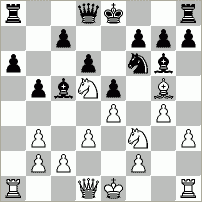
13.b4 A quiet but by no means unimportant move, as it
prevents the bishop from being played, later on, to e7 or f8.
13...Ba7 14.Nd2 c6 Too late. White must now win a piece,
we believe. His only resource was 14...h6. 15.Nxf6+ gxf6
16.Bh6 f5 At the first blush, 16...d5 looks more promising,
but it would not prevent the oncoming of the h-pawn upon the
doomed bishop. 17.exf5 Qh4 Better, we would have thought,
to have taken the f-pawn with bishop, checking. 18.Qf3
Ingeniously played. 18...e4 19.Qxe4+ Quite good enough;
but 19.Nxe4 would, perhaps, have been still more efficacious.
19...Kd7 20.Qf4 Bxf2+ Had he played 20...Rhe8+, White
would have interposed the knight, and, on Black's taking the
f-pawn with bishop, checking, have moved Kf1. 21.Qxf2 Rhe8+
22.Ne4 Qxh6 23.fxg6 d5 24.0-0 dxe4 25.Qd4+ and wins. 1-0
Illustrated London News, April 17, 1875
Playing correspondence chess and attending provincial chess
congresses still did not sufficiently satisfy Ranken's chess
passion, and it was not long before he became the driving force
behind The Chess Player's Chronicle. Although the fifth
series (or fifth incarnation) of Staunton's original publication
was short-lived, volumes under Ranken's editorial pen appearing
only in 1877 and 1878, the journal did satisfy, for a time,
a desire by the British chess public to have an organ that concentrated
on chess rather than invective. Readers at all curious about
the context for Ranken's publication are invited to see my review
of the 1877 volume, published under the title "Irregular Regularity,
or, The Fifth Series," which appeared at ChessCafe the week
of August 12, 2003, and which is archived there under the title
"Chess Player's Chronicle (New Series), Vol.1, 1877,
ed. by Rev. C.E. Ranken." Suffice it here to say that Ranken
did not single-handedly publish The Chess Player's Chronicle,
but rather received great help from a bevy of his friends and
associates, including the Reverends Skipworth and Wayte.
While engaging in his clerical duties as well as editing his journal, Ranken not only managed a correspondence chess tournament, but also played in one of Mr. Nash's Correspondence events. Given his many obligations, one can only wonder at Ranken's assessment in his first, January 1, 1877, issue, at p.22, of another Reverend's correspondence tournament. The Reverend T.H. Archdall had organized a competition attracting seventeen players, each paying one pound, one shilling entrance fee. It was to be a round-robin, with each player carrying only four games at a time. The prizes were to be 10, 4 and 3 pounds, respectively.
Of the Reverend Archall's tournament, Ranken wrote that "All credit is due Mr. Archdall for his zeal in this organization, and for his courage in undertaking to be sole conductor and referee. Our only regret is that more well-known names of first-class amateurs do not appear on the list of competitors. The task of playing four simultaneous Correspondence games is no easy one, and here may be the cause why many have not come forward. Chess, of course, only occupies our leisure hours, and few can have sufficient leisure for thoroughly analyzing the new positions in four games which are constantly presenting themselves. We shall not, therefore, be surprised to find that the standard of play is often below par. On the other hand, this state of things may bridge over inequalities among the players, as Correspondence play usually tends to do, and so increase the interest of the competition."
And how many correspondence games did Ranken carry simultaneously
in the events he entered? The answer remains, alas, unknown.
What is known, though, is that Ranken apparently had sufficient
time not only to play correspondence chess as well as coordinate
his own tournament, but to put together what must stand as one
of the more convoluted scoring methods ever suggested for arranging
a handicap correspondence tournament. Ranken's method, or perhaps
madness, is best left to the reader's opinion, as the following
explanation and chart suggest. The fifteen players entering
The Chess Player's Chronicle Correspondence Tournament
were divided into seven classes, lettered A through G. (Gossip
and Skipworth were the two grouped in class A.) A table was
constructed that showed the values to be attached to wins and
draws:

One can only imagine what the competitors thought of this scoring
method. That games were indeed played in The Chess Player's
Chronicle Correspondence Tournament cannot be denied, although
how it finished is a mystery. One example should suffice. Here,
the winner, G.H.D. Gossip, a Class A player (best known among
correspondence players, perhaps unfairly, as the victim of Mrs.
John W. Gilbert (Ellen E. Strong) and her extraordinarily long
announced mates), quickly dispatches H. Brewer, a Class B member,
for a simple A/B result … which the reader may determine the
value of from Ranken's chart. How Mr. Gossip felt about winning
only 7/8ths of a point for his victory is unknown.
G.H.D. Gossip - H. Brewer [C77]
The Chess Player's Chronicle
Correspondence Tournament, 1878
1.e4 e5 2.Nf3 Nc6 3.Nc3 Nf6 4.Bb5 a6 This move is not
as safe here as in the 'Ruy Lopez,' for White can gain an advantage
by 4...a6 5.Bxc6 dxc6 6.Nxe5 Nxe4 best 7.Nxe4 Qd4 8.Qe2 Qxe5
9.d4 Qe7 best 10.Bf4 Be6 11.Nc5 0-0-0 12.Nxe6 with the better
game. 5.Ba4 Bc5 6.Nxe5 Nxe5 7.d4 Bb4 8.dxe5 Nxe4 9.Qd4
Stronger, we think, than 9.Qg4, which is sometimes played. 9...Nxc3
10.bxc3 If 10.Qxb4 Nxa4 11.Qxa4 0-0 with an even game. 10...Be7
11.e6 fxe6 White's last move was undoubtedly the most attacking
which he could make. Of the feasible replies to it Black chooses
the weakest, the others being ...f6, and ...Bf6. 12.Qxg7
Bf6 13.Qg3

13…b5 His kingside being already so exposed, it was
a mistake thus to open the other. The correct play appears to
be 13...c6 threatening ...Qa5 followed by ...Qe5+, forcing the
exchange of Queens. 14.Bb3 Bb7 15.Ba3 Kf7 16.0-0-0 Qc8
Presumably to enable him to advance ...a5, which would be useless
now on account of the reply Qh3; but there was not time for
this maneuver, though it is hard to say what Black ought to
have done here. 17.Qh3 h5 18.Rhe1 a5 Overlooking the
crushing answer. 18...d5 was perhaps his best resource. if 18...Bc6,
White may rejoin with 19.f4. 19.Rxd7+ 1-0
The Chess Player's Chronicle, November 1, 1878, p.256
Several of Ranken's games from Mr. Nash's Correspondence Tournament
appear in his own journal. The following example, played against
a Mr. J. Bryning of Blackburn, finishes with Ranken trapping
White's Queen.
J. Bryning - Ranken [E14]
Mr. Nash's Correspondence Tournament, 1878
1.d4 e6 2.c4 b6 Reducing the opening to a species of
Fianchetto. White should, perhaps, have replied by occupying
the center with 3.e4. 3.Nf3 Bb7 4.e3 Nf6 5.Bd3 c5 6.a3 Unnecessary
here, and therefore losing time. 6...cxd4 7.exd4 Nc6 8.Be3
In this opening b2 is a preferable post for the bishop, and
the present case forms no exception to the rule. 8...d5 9.Nc3
Be7 10.0-0 0-0 11.Qe2 White hesitated to play the Queen
to c2 apparently on account of the reply 11...Rc8. 11...Na5
12.Ne5 Rc8 13.cxd5 Nxd5 14.Ne4 An ingenious conception,
as will be seen presently; but as it was not perfectly sound,
it would have been better to take the knight, and still better
to have played Rad1, instead of taking the pawn at the last
move. 14...f5 15.Ng3
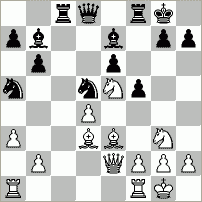
15…Bd6 Had Black attempted now to win the piece, we
believe he would have lost the game, e.g. 15...f4 16.Qh5 Nf6
best 17.Qh3 fxe3 18.fxe3 Threatening Rxf6. 18...g6 best 19.Nxg6
hxg6 20.Bxg6 Kg7 ( 20...Rf7 21.Qxe6 Qf8 22.Nf5 and wins.;
20...Qd5 21.Rxf6 Qxg2+ 22.Qxg2 Bxg2 23.Rxf8+ and wins.)
21.Rxf6 Rh8 If ( 21...Kxf6 22.Qh6 wins, and if 21...Rxf6, White
mates in two moves.) 22.Rf7+ Kxg6 If ( 22...Kg8 23.Rh7
wins.) 23.Qxe6+ and wins. 16.f4 It will be found on examination
that the removal of Black's bishop obliges White now to prevent
the advance of the f-pawn. 16...Nb3 17.Rae1 The rook
should have rather been played to d1, but Black could even in
that case have still won the pawn. 17...Nxe3 18.Qxe3 Nxd4
19.Kh1 Bc5 20.Rd1 The Queen ought, of course, to be removed
from the line of the bishop, yet she has no good square to go
to. 20...Nf3 21.Qe2 Nxh2 22.Qh5 An interesting variation
would have occurred at this point had White now taken the f-pawn,
e.g. [ 22.Bxf5 Qh4 23.Bxe6+ Kh8 24.Qh5 best 24...Qxh5 25.Nxh5
Nxf1 26.Bxc8 Bxg2+ 27.Kxg2 Ne3+ 28.Kf3 Nxd1 29.Be6 g6 and wins.]
22...Nxf1 23.Bxf1 Bd5 Better than moving the Queen, which
would have allowed the adverse rook to go to d7. 24.Be2 Rf6
25.Qg5
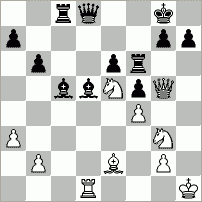
25…Be7 It is remarkable that the Queen now has no escape.
Had Black instead checked with the rook, White would have covered
with his knight, threatening mate, and Black could not take
the Queen without losing the exchange. 26.Kg1 Rh6 0-1
The Chess Player's Chronicle, May 1878, pp.109-111
Ranken's editorial stint ended with the 1878 volume of The
Chess Player's Chronicle, and the following twenty-some
years beginning with January 1881 saw him appear frequently
as game annotator and commentator on chess events in the pages
of the British Chess Magazine.
Ranken's amateur playing career ended in mirror-like fashion with how it began. While at London 1851 he finished second in the Provincial Tournament, forty-four years later he played in the Amateur Championship at Hastings 1895, finishing a disappointing second to last, at 2½-4½. By then he was 67 years old and had not competed for a decade. At his death ten years later, Ranken bequeathed his chess library to the Cheltenham and Worcester Chess Clubs.
He also bequeathed us all some exciting, if not always sound,
chess. And if anyone doubts the Reverend Ranken reveled in complications,
take a look at the concluding over-the-board game in this article,
one found sufficiently interesting to be included by Tartakower
and Du Mont in their 500 Master Games of Chess. Fittingly
enough, the game pitted Ranken against his good friend.
Rev. William Wayte - Rev. Charles E. Ranken
[C44]
England, "About" 1885
One of the many fine games played between the two reverend
gentlemen, but a particularly thrilling one. The practical chances
afforded by the early sacrifice of a piece in this opening (5...Bc5)
are exploited here by the aggressor in an admirable manner.
1.e4 e5 2.Nf3 Nc6 3.c3 Nf6 Emphasizing the fact that
the natural defense of White's threatened e-pawn by the Queen's
knight is not available here. 4.d4 Nxe4 He accepts the
challenge. Other continuations have few adherents, including
4...exd4, 4...d5, and 4...d6. 5.d5
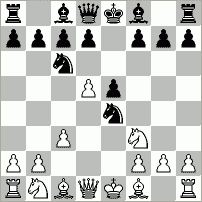
5…Bc5 A bold sacrifice! More logical, however, is 5...Nb8.
After 5...Ne7 the amusing continuation of a game Bachmann -
Kunstmann, Augsburg, 1899, ran as follows: 6.Nxe5 Ng6 7.Bd3
Nxf2 8.Bxg6 Nxd1 (or 8...Qf6 9.Qe2 Nxh1 10.Bxf7+ Kd8 11.Nc6+
followed by mate) 9.Bxf7+ Ke7 10.Bg5+ Kd6 11.Nc4+ Kc5 12.Nba3
(threat: 13.b4 mate) 12...Nxb2 (or 12...a5 13.Bxd8 remaining
a piece ahead) 13.Be3 mate. 6.dxc6 Compulsory courage,
for if he refuses the offer, Black, after 6.Be3 Bxe3 7.fxe3
Nb8 etc. has the better game. 6...Bxf2+ If 6...Nxf2 7.Qd5.
7.Ke2 d5 He does not count the dead, for after 7...bxc6
8.Qa4 f5 9.Nbd2 etc., Black's attack dies away. 8.cxb7 Bxb7
9.Qa4+ c6 10.Nbd2 f5 11.Nxe4 fxe4 12.Kxf2 If 12.Nxe5 Bb6
and now 13.Nxc6 is inadmissible because 13...Qd7 wins the knight.
12...0-0 13.Be3 exf3 14.g3 After 14.gxf3 e4 White's troubles
are only beginning. 14...Qc8 15.Bc5 Rf6 16.Rd1 a5 17.Rd2
Ba6 With two pawns and an enduring pressure for his pieces,
Black does not fear exchanges. 18.Bxa6 Qxa6 19.Re1 e4

20.a3 He underestimates the danger, and goes to work
too methodically. By at once playing 20.b4 White would be better
able to weather the storm, e.g. 20...Qb5 ( 20...Qc8 21.bxa5
etc.; 20...axb4 21.Qxa6 Rxa6 22.cxb4 with a simplified
position.) 21.Qb3 etc. 20...Qc8 An ultra-rapid change
of objective. 21.Kg1 Qh3 22.b4

22…Re8 He abandons the queenside and proclaims the central
zone as the main battlefield. 23.Qxa5 h5 A turning movement.
24.Qa6 If 24.Bf2 Black still plays 24...h4. 24...h4
25.Qf1 Qg4 26.Qf2 Or 26.Bf2 hxg3 27.hxg3 Rh6 with 28...Qh5
to follow. 26...Rg6 If at once 26...hxg3 27.Qxg3. 27.b5
A desperate attempt! But the only possible defense would be
27.Kh1 and after 27...hxg3 28.Qxg3. 27...hxg3 28.hxg3
If now 28.Qxg3 Qf5 winning the Queen. 28...Rh6 Encircling
the King and threatening 29...Rh3, followed by ...Rxg3, which
White's next move is intended to prevent. 29.Be3 Rh3 30.Bf4
Qh5 Threatening to turn White's extreme right wing. 31.Qh2
The only resource. 31...Rxh2 32.Rxh2 Qg6 33.b6 The last
trump. 33...e3 A deflecting sacrifice. 34.Rxe3 Rxe3
35.Bxe3 Qxg3+ 36.Kh1 Qe1+ 37.Bg1 Qxc3 and Black wins.
0-1
500 Master Games of Chess, by Tartakower and Du Mont
(Dover Publications, 1975 rpt. of the 1952 edition), pp.194-195

Solution to Problem: 1.Ne7+ Kxe7 [1...Kxe5 2.Qe3 mate] 2.Qc8
Nf6 3.exf6 mate 1-0
© 2005 John S. Hilbert. All rights reserved.
|